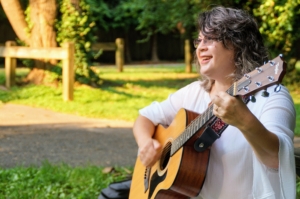Connectivity: God or the Internet?
In the pandemic years, we witnessed significant changes in how Jews gather to pray. It has been most evident in how we utilize television and live streaming to pray from the comfort of our homes. One notable example is the Central Synagogue’s services, featuring the esteemed Rabbi Angela Buchdahl, a top-rated Jewish “program.” The impact of these professional and meaningful offerings on Jewish prayer is profound, both as a blessing and a challenge.
Technology influences our connections within our communities. The pandemic forced many of us into confinement at home and seeking solace, we turned to electronic media.
Synagogues have sought to make services accessible long before the pandemic. Adas Israel, in Washington, DC, pioneered this approach, broadcasting services on the radio. Such broadcasts aimed to accommodate those who were ill or elderly and couldn’t attend in person.
The Romemu community in New York championed Zoom and live-streamed services before Covid. Their approach respected virtual participants, offering a membership category for internet participants. Romemu elevated the technological approach to prayer, making the experience more personal and highly professional.
Zoom provided life cycle event connections for a Shiva minyan or a bar/bat mitzvah service. It also allowed smaller communities to sustain daily minyans. Zoom services welcomed individuals who couldn’t previously participate in communal prayer. There are compelling reasons to support a Zoom minyan.
Yet, fulfillment of your prayer obligations was not through electronic media. Ten people had to attend to complete a prayer service minyan. Then Covid happened. Progressive segments of the Jewish community accepted remote participation. Progressive Judaism already tends to emphasize the individual’s needs. Accordingly, virtual presence was equivalent to in-person participation.
The idea of remote participation expands upon Jewish law. The Talmud teaches that synagogues must have windows to connect worshippers with the outside world and allow those outside to join the service. Similarly, Mishnah Rosh Hashanah teaches us that hearing the shofar outside a synagogue fulfills the obligation. This inclusivity aligns with the spirit of live stream services.
A person standing near windows or doors to the prayer space, with visible eye contact, could be counted as part of the minyan. Another source even suggests that ten people standing in a field, able to see and hear one another, constitute a minyan. If someone standing outside a window can be counted, why not include those in a Zoom room participating in a service?
Should online services relieve us of the obligation to gather physically as a community? Or we must ask ourselves: do the benefits of a Zoom minyan outweigh the tradition of gathering in person?
The Conservative Movement’s Committee on Law and Standards (CLS) has questioned the continued use of the Zoom minyan. They suggest it should be limited to emergencies, such as a pandemic or natural disaster.
Psychologically speaking, they might be right. Words can offer comfort, and voices can provide support, but they cannot replace the touch of a hand, a hug, or physical presence. Those who cannot be touched, whose hands we cannot shake, whose smile we cannot see, remain alone.
The pandemic taught us that isolation can cause harmful loneliness. Technology rescued us from seclusion but did not fully replace the warmth of human connection.
The best forum for fostering connection is in the spiritual setting. You may sit in a theater with a crowd of people, but you aren’t forming a community. You can attend a sporting event, but a gathering of fans won’t satisfy your need for meaningful relationships. As social as pickleball and book clubs may be, I’m not sure such leisure activities create significant personal connections.
Jewish tradition understands the profound spiritual significance of coming together face to face, heart to heart. When gathering for a life cycle ritual or a holiday service, we have the opportunity for something profound to happen. We are meant to be present, share our joys and sorrows, and support one another on life’s journey.
Don’t mistake the convenience of online participation for spiritual fulfillment. The crisis of loneliness still looms over our society.
Through simple yet profound acts of connection, we can heal the wounds of isolation that plague our world. If not for yourself, your sense of loneliness your physical participation may be a blessing to someone else who needs more personal relationships.
We must reaffirm our commitment to one another and the idea that our faith communities are not just places of worship but sanctuaries of love and fellowship. We must be beacons of light in a world that sometimes feels dark and disconnected.
Despite the technological allure leading to isolation, God’s presence is most powerful when we come together as a community. The spirit of unity and togetherness is a testament to our shared humanity, and it is through these connections that we find God’s love. In an age of screens and gadgets, we must remember that God and not the internet is the connection between people.
Let’s prioritize gathering in person, not just for religious purposes, but for the sake of ourselves and the well-being of our neighbors. It is in these connections that we find strength, hope, and the ability to overcome the crisis of loneliness that plagues our society.
While technology can connect us across distances, it cannot replace the power of physical presence and the warmth of human touch. We must balance embracing modern tools and upholding the traditions and values that have sustained us for generations.
Rabbi Evan J. Krame





 Evan J. Krame was ordained as a rabbi by the
Evan J. Krame was ordained as a rabbi by the